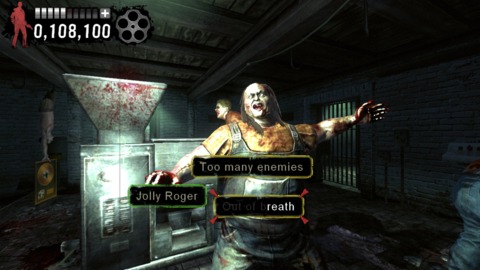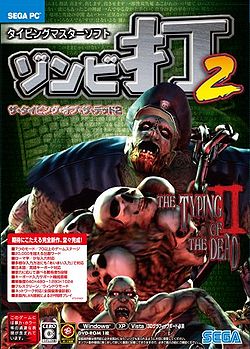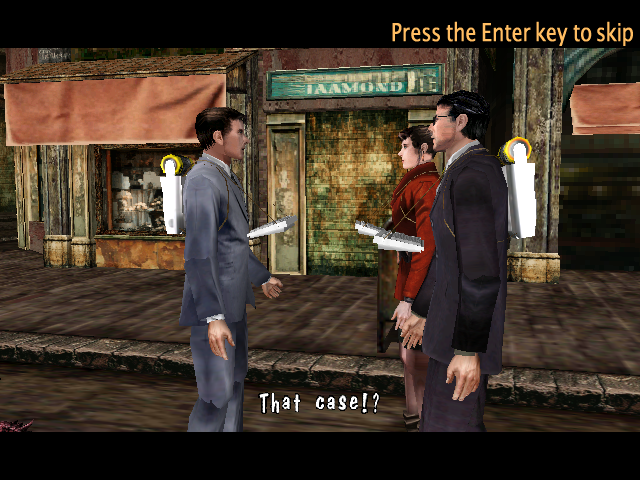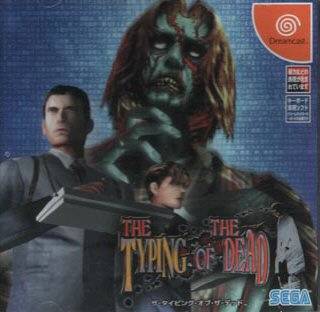Typing of the Dead: Overkill was both announced and released on the same day, Halloween.

But Typing of the Dead: Overkill shouldn’t have happened. Studio closures are supposed to kill projects, especially smaller ones. Yet in late October, Modern Dream and Sega unexpectedly revitalized a beloved spin-off, and reminded us how much fun it is to be told you’re bad at typing.
The idea for a new Typing of the Dead game came out of Sega’s London office, part of the company’s increased focus on digital games. Typing of the Dead may not seem like the most obvious choice for an update, but House of the Dead: Overkill was a hell of a game, one that embraced the series’ unintentionally goofy vibe and successfully merged it with a grindhouse aesthetic. It was also hilariously, unapologetically crude.
And it’s not like the franchise has been dead in the water, either. In 2008, Sega developed Typing of the Dead 2, based on House of the Dead III, but never released it outside Japan. Flick of the Dead was a port of the original game for iOS, but like Typing of the Dead 2, it never left Japan.
But the plan for adding a typing mechanic to House of the Dead: Overkill came out of the West, so at least in this case, the rest of the world would finally be able to pop zombie heads by tapping out a few words.
If it came out, of course.
Blitz Games Studios was one of several developers who talked to Sega. Part of the reason Blitz won the contract was the studio’s experience porting the House of the Dead: Overkill engine from Wii to PlayStation 3. Blitz started work on transforming House of the Dead: Overkill into a typing game in June. Yes, this past June. The assignment was a rough one: in less than six months, completely change the mechanics of a light gun shooter, port it to PC, and add multiplayer.
The tight development window would have been enough stress for the tiny team assigned to Overkill, but in retrospect, it was probably the lesser of the two major problems the project faced.
“We found out on the 12th of September that the company was going into liquidation,” said former Blitz project manager Ollie Clark. “I remember hearing that first thing in the morning.”
Blitz had been around for 23 years, a staple of the UK development community. Management said a lack of investment in “major projects,” changing strategies for projects in development, and slow negotiations over some potential games had finally done the studio in. Personal savings had been keeping Blitz afloat for a while, but in mid-September, it was no longer tenable.
“I went and spoke with a colleague of mine, Tom Weston, who was the company manager of business affairs at the time,” said Clark, “and just spoke to him and said ‘What are the chances of getting this game out?’ And he said ‘Not a chance.’ That would normally be the end of it. We would do what studios do when they go under, which is go down to the pub and drink our sorrows away.”
By coincidence, Clark had been developing his own games on the side under the moniker Modern Dream, and had already been talking to an accountant about setting up a studio. Now, he tasked his accountant with figuring out something much more ambitious: setting up a developer to house 10 employees. Weston set up a meeting with Sega, one where Clark hoped to convince the publisher to give him a chance.

“They [Sega] very kindly, and at their own risk, decided to support us in finishing the game,” said Clark. “So we met as a team on a Sunday, and decided that we were gonna do it.”
The very next day, everyone headed to Clark’s apartment. That included lead designer and writer Jonathan "Jogo" Evans and technical lead Tim Page.
“It was me and two other coders trying to sort out the logistics--can we get the servers up and running?” said Page. “Can we get the code compiling? Have we got everything we need to get the engine running, now that we’re not at Blitz anymore? And there were all sorts of problems we had to overcome, so we were having a frantic time. By the end of two days doing that at Ollie’s house, we’ve got the game building at that point. From the coder’s point-of-view, we could do it, at that point. Then, it was just for Ollie to prove out that legally and logistically that we could.”
Not only was Clark able to strike an agreement with Sega that kept Overkill alive, but Sega even had space to house the team at a studio nearby. All told, there were only four days of downtime for Overkill, a remarkable feat for a game that, in most circumstances, would have surely died.
“It was blind luck, really, that Sega just happened to have a development studio in our town,” said Evans. “There’s not a lot of towns that can actually boast that. We could have been anywhere else in the country, and been in a lot of trouble. Possibly terminal.”
When the game was first in development at Blitz, it took a week to get the game engine running on PC. Sega had archived much of Overkill’s assets but not everything, which meant certain elements had to be rebuilt. Even when the typing mechanic was implemented, it had enormous implications for very basic elements of the game design. Zombies had to be repopulated throughout the world, boss fights had to be reconfigured, multiplayer was being created from scratch, and there the dictionaries had yet to be written.
Multiplayer was just recently added to the game as part of a patch.
“Because if you imagine,” said Clark, “there are two virtual universes that essentially don’t know about each other and have to talk to each other in just a few 1s and 0s and explain where they are and what they’re doing. If it goes out of sync at any one point, it’s like the multiple universe quantum theory. As soon as one starts to go out in one direction, it’s entirely different from one another, so you have to keep re-checking that they’re synching up with one another time and time again in multiple places. It’s an incredibly difficult thing to do. There are studios that just do multiplayer games because it’s very, very difficult to build up.”
Sadly, purely due to logistics, local multiplayer with multiple keyboards was tossed out pretty early.
But potentially crazy multiplayer aside, an enormous part of what made Typing of the Dead special was its sense of humor. Even more so than the original shooters, Typing of the Dead had a feeling of whimsy that was wonderfully at odds with the on-screen violence. So it’s not as simple as plucking a bunch of words from the Internet and calling it a day. You could do it that way, obviously, but it wouldn’t be Typing of the Dead.

The team had several ways of coming up with words, including simply sitting down a dictionary and jotting down what words caught their attention. A couple of developers even wrote phrase generators--spitting out a small ditty with a verb, noun, and an adjective--pulled from hundreds and hundreds of words. For the most part, though, Evans said the game’s best writing came from paying attention to the world around them.
“I spent the last three months writing notes to myself,” he said, “and scribbling things down on post-it notes and jabbering things into my phone every time I encountered an interesting phrase. It’s almost been logging the universe for the last three months.”
“One of the programmers told me this game would ruin language for me forever,” he continued, “because every time somebody says something interesting to you now, you think ‘oh, I should have put that in the game!’ [laughs] So it’s going to be very difficult. [...] As much as the game content is ridiculously offensive, we tried to keep everything that you had to type much more clean and mild. I still think ‘oh, what an asshole’ when I get to type Mississippi. [laughs] This is my fault. What did I do that for?”
As development on the game progressed, the team encountered surprising and unexpected moments, thanks to the typing mechanic. For example, Sega community managers were brought in to help test the game, due to their ability to type at ungodly speeds. Modern Dream soon discovered the game was unable to keep up with them. The tech was built to read a keystroke per frame, and had to be adjusted to even keep up.
“One of the most senior members of Sega Japan--Typing of the Dead was the first game he worked on at Sega, so it had a real value to him. The message was passed down to me: don’t screw this up.”
Modern Dream also had to look at the game’s many nuances, and decide which to keep. In the original game, you don’t have to worry about hitting spacebar in-between words. Overkill kept that. The original required players to type all punctuation, which Overkill ditched for the normal difficulty but kept around for the “hardcore” mode. Difficulty modes are actually a series first, too, with Modern Dream noting how many players loved Typing of the Dead but were never able to finish it. (For the record, I am one of those people. I kept dying at that maddening final boss.)
Despite adversity, the team hit Sega’s Halloween deadline. But as noted, this wasn’t an anticipated release. Sega sent out a press release about Overkill on Halloween morning, and it was on Steam later. On the day it launched, Modern Dream was still working.
“I had a massive deadline looming,” said Evans, “and then at five o’clock, [everything] ground to a halt because [of] Twitter. I put a Typing of the Dead search into Tweetdeck, and I’ve never, ever seen activity like that. It just went absolutely incredible. One of the things we didn’t actually know was whether the love for Typing of the Dead still existed.”
Suddenly, the team was faced with a reality it hadn’t quite yet fully considered: maybe the game sucked.
“The weight of nostalgia,” said Clark.
That nostalgia wasn’t just fans, either. It was also coming from Sega’s upper echelon.
“One of the most senior members of Sega Japan--Typing of the Dead was the first game he worked on at Sega, so it had a real value to him,” said Clark. “The message was passed down to me: don’t screw this up.”

By most accounts, including yours truly, Modern Dream did not screw it up. Overkill is a worthy addition to the Typing of the Dead series, and hopefully signals to Sega it should stick around. But it’s easy for Modern Dream to still imagine a universe where the game was never finished and this conversation was all hypothetical.
“Probably the biggest thing to take from this is that if you really love a game, keep going with it, no matter what,” said Evans. “If it had been many other games we’d have worked on over the years, would we have carried on? I don’t know. But this one, it was just so fun making it and playing it. Just keep going.”
Before I let the team go, though, I had to ask a very important question. In the original, characters ran around with keyboards strapped to their chests. It was so ridiculous. The moment the question was out of my mouth, the team was in hysterics. Modern Dream had considered how to include this detail in Overkill, but the production value of the original assets meant the team would have been required to build new animations.
“You know I said there were 10 people on the team?” said Evans. “Guess how many of them were animators? [laughs]”